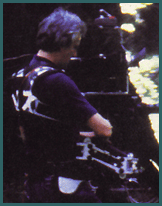The roll-cage got a workout during these curving shots, and we made at least one take with banked turns for each pass which was kept level. It proved extremely difficult for Dennis to judge the correct slow rate of banking with his remote control, and when you consider that his moves are to be seen at 30 times the shooting speed, I think he did amazingly well. Certainly his years of laying out motion-control timings helped in this regard.
On the first location I was in some pain from a minor bit of surgery on my left foot, but dealing with all of these complications was so absorbing, that I literally felt nothing until the end of each take. It was the only time in my career during which the walk back to the start was worse than the event itself. Owens is terrific, schlepping the rig back for me each time to cut down on the wear and tear. In addition, he had to practically dismantle the camera to reload the special daylight-hundred-foot spools, plus keep track of the footage expended by means of a stopwatch, since we had no frame or footage counter onboard not to mention calculating exposure at 3/4 frame. The forest was so dark much of the time, that we were exposing at T.4 notwithstanding an effective ASA of 2560!
I enjoyed watching these two "indoor" guys deal with the realities of "outdoor" shooting. Dennis and Michael are accustomed to the timeless air-conditioned confines of the stages of ILM. Shooting in the real world provided them with a number of surprises. We could not locate the thermostat for regulating the temperature of the forest, nor the dimmers for adjusting the amount of light, which itself seemed to constantly shift direction from morning to night. Dennis was also annoyed by hordes of the local "Mini-flyers of Endor" strange biting small craft which stubbornly refused to attack him at any speed other than 24 frames per second. (Since I was undercranking, I was of course immune!)
The final shoot commenced on September 20, and was designed to give us a chance to get any remaining shots which were needed for the cut version, and to re-do any that didn't work the first time. One of these latter involved a rapid move under a fallen log which was useless because the original course was too short. As I recall, we remade this one, but scrapped another experiment that actually involved a live person, our amiable and talented second assistant Randy Johnson, who was in costume to double Luke Skywalker, brandishing a sword at 1/30th speed as we roared down at him at a simulated 90mph. (He eerily resembles Mark Hamill, so the scheme should have worked, except that once again it is difficult to judge moves appropriate to this degree of time compression. I am told that in dailies it looked like we were running down a hyperactive puppet grandmother.)
This second adventure in the forest gave us an opportunity to experiment with the fearsome "sideways" version, in which the Steadicam is allowed to float horizontally, and the camera is re-erected by turning the roll-cage 90 degrees. I made this ill-advised suggestion in response to a request from Dennis Muren for some shots that would appear to fly directly over the ragged undergrowth. It worked beautifully but proved to be difficult to tune, since the camera was aimed off to one side, and somewhat above vertical, and therefore any balance adjustment to the straight-ahead-looking Steadicam caused the camera to assume a different angle. The new model III proved its worth by permitting a much larger number of adjustable components to actually adjust!
There you have it! A tour de force, if not a tour detour. From the standpoint of cost, it was clearly effective. Dennis informs me that the miniature model scheme would have gone at least five times as much, and even the restricted dolly version would have cost 50 percent over our final budget, despite the large sums spent upon lightening the VistaVision camera. It has certainly been a very gratifying assignment for me. I don't think I have permanently harmed my brain, and having just passed my 40th birthday at the time, I was happy to find that I could still get the old legs up over 100 mph. I look forward to the opportunity to shoot even faster plates, perhaps breaking the sound barrier. As soon as I can remember my address, I will collect some clean socks and I'll be ready.
